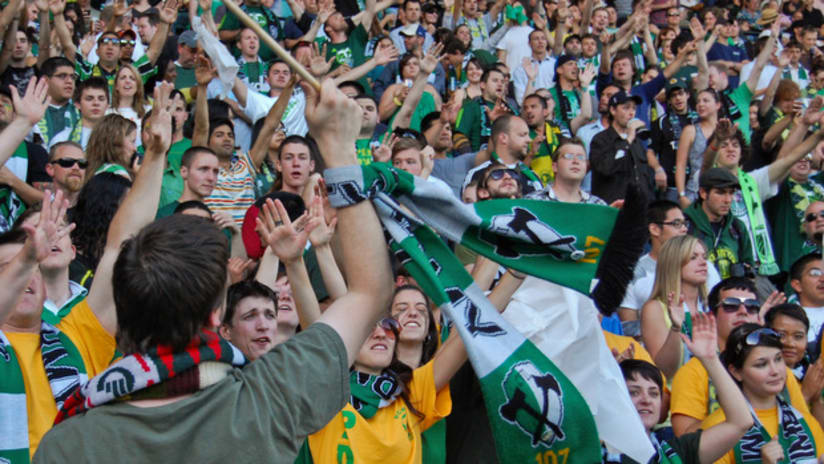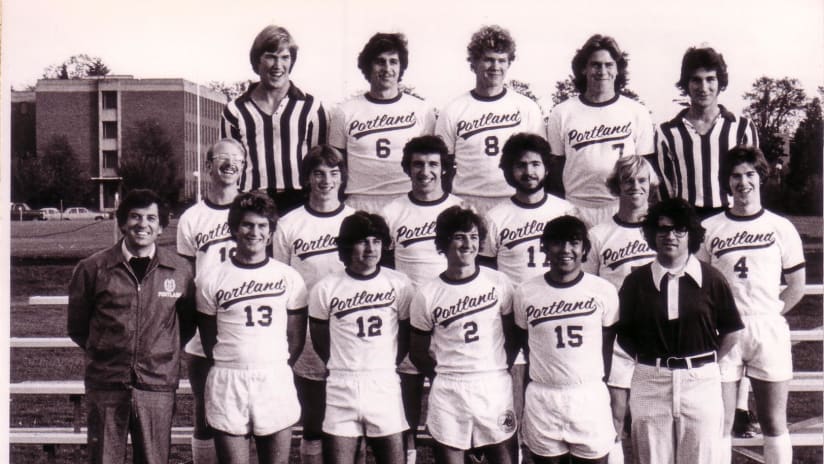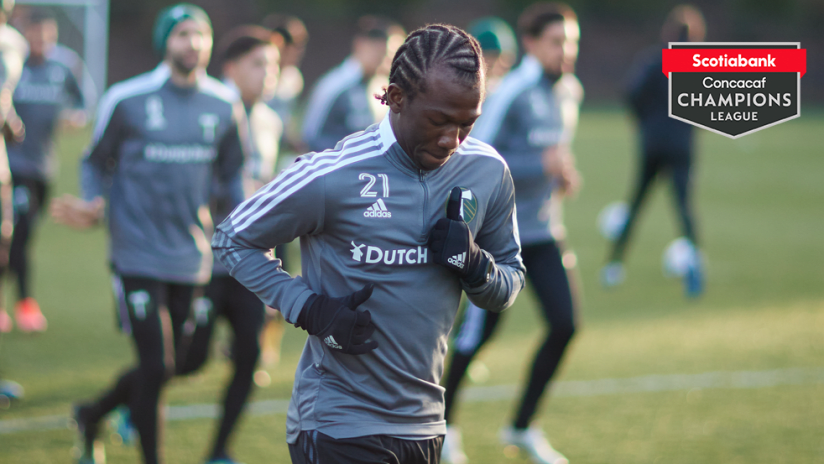Editor’s Note:With the Portland Timbers 2011 inaugural season commencing this Saturday against the Colorado Rapids (6:00 p.m. PT; ROOT SPORTS, FOX Soccer; KXL 750), we reached out to longtime Timbers Army member Kip Kesgard to talk about the journey to this day from a supporter’s perspective. Kesgard, also a writer for Oregonlive.com, has been sitting in the North End since 2004.
As my wife and I drove towards the Horizon Airlines hangar to watch the Portland Timbers kit unveiling back in December, my mind was full of thoughts about the future of the Rose City’s newest major professional team. Walking into the facility, I witnessed the large ice sculptures with the Timbers logo, the kiosks that would soon hold new team merchandise, and a handful of food and drink stations to feed the invited guests. I remarked that we’re definitely not in the United Soccer League anymore.
While the USL/USSF D-2 Timbers were one of the best run and well-organized teams in the league, the league itself operated on a minimalistic structure and a shoestring budget. At the Timbers rebirth in this league in 2001, with relatively sparse crowds in other parts of the stadium, a small but extremely vocal group of fans gathered in the North End each game night to sing and chant their team to victory. I joined the fringe of this group, this Timbers Army, in 2004 and I found out how passionate this bunch was in following the club and the unique challenges that surrounded their efforts.
At this point, there was a single website to obtain game statistics, but not every club offered radio or television coverage of matches. Fans shared information with other Timbers fans by email or text from various parts of the world or on fan-generated message boards.
Longtime Timbers supporter Gisele Currier talked about how information traveled in the club’s first years in the USL. “The first season, you had to be in the soccer community to find anything out for the USL Timbers. I remember getting info from Brian Gant and Clive Charles before the newspaper ever printed a word. The next season, it was all up to Allison Andrews and the Soccer City USA board. If we hadn't been sitting in 107, we would have never have known about SCUSA or most Timbers news stories.”
Currier has been following the club since the days in NASL, and communication during those times had its own unique challenges. “In the NASL days, a lot of the things going on about the team were in the newspaper, the only place to find anything out. We didn’t have computers for keeping us up to date. And the boosters were needed more back then most of all because we had a chain phone call committee to let people know when things were going on. I remember phoning the office on a regular basis to see when the training would be starting. From there we would go to practice once or twice a week, and our information came from the players.”
Timbers supporter Tim Chamberlin has been following the Timbers since 2004, learning first hand how information travels in lower division American soccer. “I started following the Timbers early in 2004 and for the first few years it was amazingly difficult to follow the team on the road,” he said.
Though many games were on the radio, they were rife were problems. Most notably, signal strength, “They reminded me of the jazz station from The Simpsons where the producer said they have a ‘broadcast range of 23 feet, and that makes us the most powerful jazz station in the US of A.,’” remembers Chamberlin.
Expectations changed when USL Live’s match webstreaming came around, but as Timbers supporter Matt Talley found out, the challenges just became more unique. “In the early days, a key word amongst the Timbers Army was ‘buffering.’ Lags in the real time action caused often painful delays and cries of ‘Come on!’ in tones of pure agony,” Talley ruefully remembers.
[This season,] catching the Timbers on the road will be as simple as flipping on the TV. But in the halcyon days of the Timbers Army, the opponent and buffering were the enemies, and yet we endured.”
Nothing really emphasizes the difference between the former era of USL and the new world of MLS than actually attending a match, especially one on the road. It was with that thought in mind that I ventured up north to take in day two of the recent preseason Cascadia Summit. Hosted by the Seattle Sounders FC, the three day competition featured matches with all three Pacific Northwest clubs: Seattle and Portland on March 4, Portland and Vancouver Whitecaps FC on March 5, and Seattle and Vancouver on March 6. The weekend also featured a Supporters Roundtable and a Coaches Panel, where all three head coaches would entertain questions from fans.
As I arrived on March 5, the Supporters Summit was just wrapping up, but I saw members of the three supporters groups interacting and it was a most welcome sight. Whitecaps Southsiders chatting with Emerald City Supporters, while Timbers Army listened intently, and vice versa. Even the late arrival of the Southsiders because of issues at the U.S./Canada border didn’t dampen the spirit of the afternoon, as the ECS and Timbers Army membership spoke openly about the challenges of bringing all three clubs to MLS while also fostering growth and cohesion in the supporters groups.
Steve Clare, the editor at Prost Amerika, a Seattle based soccer website that is based in Seattle remarked, “The fans up here [in Seattle] are starting to understand that the three Cascadia clubs could dominate MLS if they work together as a group. It’s for the benefit of everybody that we find things to agree upon.”
Perhaps this is the biggest change I noticed moving to MLS, this sense of collectiveness amongst the supporter groups. At the end of the day, soccer fans want to grow the game by making matches the place to be, and that won’t happen if people don’t feel safe. While it’s OK to give the opposing fans some grief during the game, it’s important to be cordial and friendly by working together for the greater good. Timbers fans were playing soccer with Southsiders at the Summit, while everyone was embracing the game and the spirit of the weekend. I think it’s to the benefit of all three clubs to continue something like this every off-season and feel the hosting duties could be done on a rotational basis, giving fans the chance to travel to other cities and engage in their hospitality.
To look on the cusp of MLS arriving for Portland this weekend, fans now have a wide range of informational websites that talk about the team and share news about everything from player signings to community outreach. While the new era will be amazing, we shouldn’t forget about the path that got us to this point and that all starts with bringing together the soccer community in a mutual love of the game. As bright as the future of the club might be, it’s the foundation of the past that allows us to enjoy the new era of Timbers soccer.












